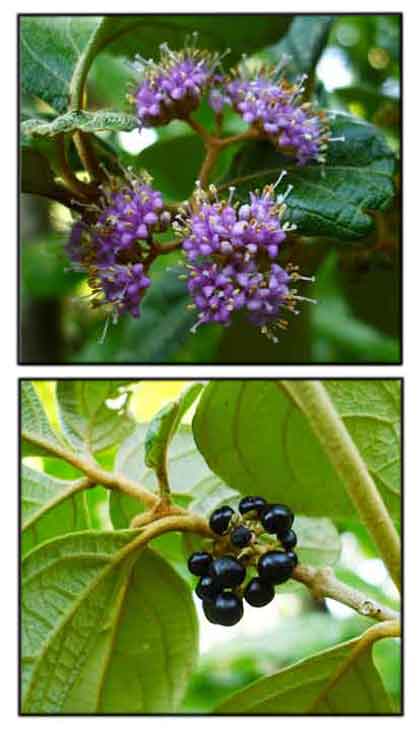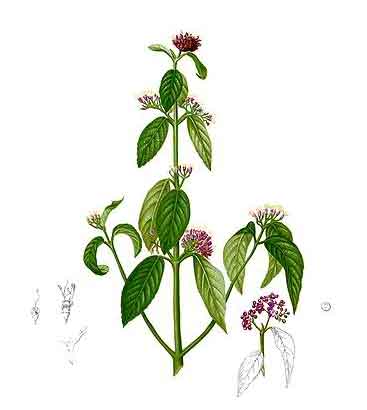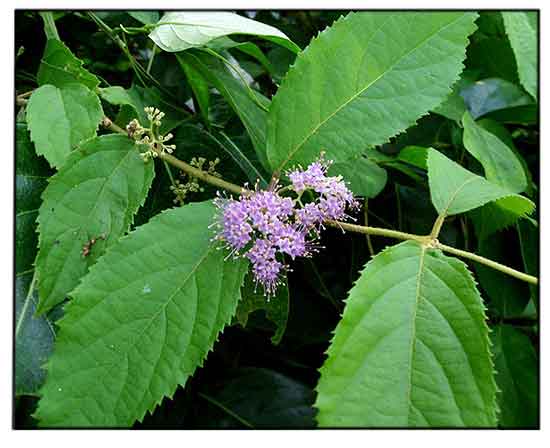Gen info
- Callicarpa (beautyberry) is a genus of shrubs and small trees in the family Lamiaceae.
- Callicarpa candicans is a species of flowering plant in the mint family.
- Etymology:
Callicarpa means "beautiful fruit" from the Greek words words kalios (beauty) and carpos (fruit). Candicans is Latin for "whitish." (7)
- In the Philippines, there are 27 species of Callicarpa, of which 19 are endemic.
 Botany Botany
• Tigau is an evergreen shrub or small tree, 2 to 4 meters high. Young branches, inflorescences, petioles, and lower surface of the leaves are densely covered with short, grayish or whitish, stellately arranged hairs. Leaves are oblong-ovate, 6 to 14 centimeters long, 2.5 to 5 centimeters wide, sharply toothed at the margin, and pointed at both ends. Cymes are short-stalked, borne in the axils of the leaves, and 2 to 4 centimeters long. Flowers are pale purplish or lavender, and about 3 millimeters long. Fruit is fleshy, pale lavender, rounded and 4 to 5 millimeters in diameter.
C. cana differs from C. americana in having stems and leaf undersides more tomentose, and especially in the racemes being more lax, the berries in the latter crowded together to look like one fruit.
• Shrubs 1-2 m tall. Branchlets 4-angled, with dense gray stellate hairs. Leaf blade elliptic, ovate-elliptic, or broadly ovate, 8-15 X 4-7 cm, densely serrate, abaxially with dense gray stellate hairs, adaxially turning blackish when dry and glabrous to pubescent along veins, base acute to cuneate, margin densely serrate, apex acuminate to acute. Cymes 2-3 cm across; peduncle ca. 0.5 cm, with dense gray stellate hairs; bracts small, linear. Calyx obscurely 4-dentate to subtruncate, with dense gray stellate hairs. Corolla pinkish to pink, ca. 2 mm, with sparse stellate hairs. Filaments ca. 2 X as long as corolla tube. Ovary glabrous. Fruit black-purple, ca. 2 mm in diam. (Flora of China)
Distribution
- In thickets and secondary forests at low altitudes from northern Luzon to Palawan and Mindanao, in most or all islands and provinces.
- Also occurs in the Malay Peninsula and Archipelago to the Bismarck Archipelago, and in the Marianne, Caroline, and Palau Islands.
 Constituents Constituents
- Study isolated a fish-killing component, callicarpone, C20H28O4, from the leaf of Callicarpa candicans. (see study below) (5)
- Studies have isolated diterpenoids, triterpenoids, and flavonoids.
(11)
- C. candicans leaf essential oils were dominated by sesquiterpene hydrocarbons and oxygenated sesquiterpenes. (E)-Caryophyllene (19.0%, 7.1%, and 15.3%), β-selinene (6.2%, 5.7%, and 4.5%), caryophyllene oxide (2.9%, 13.4%, and 3.4%), and atractylone (37.7%, 4.2%,and 42.4%), respectively, for the samples from Nghia Dan, Dai Loc, and Hoa Vang, were the major components. (11)
- Stem bark essential oil was also rich in (E)-caryophyllene (7.8%), β-selinene (7.9%), caryophyllene oxide (11.1%), and atractylone (6.2%). (11)
- Three of six peaks in HPLC-DAD fingerprint study for di- and triterpenoid components were structurally confirmed as ß-sitosterol, abietic acid, oleanolic acid and/or ursolic acid. Compound corresponding to callicarpone was observed only in C. candicans fingerprint. (see study below) (12)
- Hydrodistillation of fresh and dry leaves for essential oil yielded 0.263% for fresh leaves and 1.503% for dry leaves. A total of 47 components were identified from fresh leaves oil and 39 constituents from dry leaves oil. Chemical compositions of the two were similar, with major components being
α-gurjunene,
δ-cadinene, ε-caryophyllene (ß-caryophyllene) and α-selinene. (13)
- Study of leaves for essential oil yielded dominant components of caryophyllene (10.45%), cadinene (10.28%), gurjunene (8.95%), muurolene (8.92%), selinene (7.06%), and copanene (5.40%).
(see study below) (17)
Properties
- Fruit is said to be poisonous to chickens. Also, used as poison for fishing.
- Leaves considered emmenagogue, depurative, and vulnerary.
- Studies have shown antibacterial, fish poison, mosquito larvicidal, molluscicidal, cytotoxicity, antitubercular, anticancer, acetylcholinesterase inhibitory properties.
Parts used
Leaves, flowers, bark, roots.
 Uses Uses
Edibility
- Roots sometimes used to make herbal medicinal drinks.
- In Yap, fruits reportedly sometimes eaten raw.
(9)
Folkloric
- In the Philippines, leaves are smoked to relieve asthma.
- Leaves used in traditional medicine for wound healing and tretment of tuberculosis.
(13)
- The Atii Negrito indigenous group of Guimaras Islands used the plant to treat swollen muscles by applying grounds leaves as poultice. (13)
- Sap from crushed leaves is applied to wounds. Also used for treatment of scabies, eczema, and psoriasis. (13)
- In the Cordilleras, leaves used to relieve stomach aches. (16)
- In Camiguin, leaves mixed with leaves of anhelika (Kalanchoe pinnata) and mayana (Plectranthus amboinicus) used for vomiting. Leaves mixed with roots of Bambusa bambos used for treatment of internal hemorrhage. (18)
- Fresh leaves applied externally as plaster for gastralgia.
- In India, root decoction is given for fever and to remove hepatic obstruction. Also used for skin diseases and as a wash for aphthae in the mouth.
- In Malaya, leaf decoction used for abdominal problems.
- In Java, decoction of leaves used for bringing on menstruation. Leaves used for poulticing boils and wounds.
- In Indonesia, used for skin rash and skin inflammation caused by bacteria. (8)
- Infusion of leaves used as depurative.
- Use of the plants similar to those of Callicarpa americana (American beautyberry). C. americana is used as a folk remedy. As insect repellent, the leaf is rubbed on the skin to deter ticks, ants, and mosquitoes. Root bark is used as diuretic, and as treatment for dysentery and stomachaches. Decoction made from berries and roots used to treat colic.
- In Yap, flowers, bark, and leaves used as medicine. (9)
- In traditional Vietnamese medicine, plant used to prepare a tonic, to treat diseases of the liver and stomach externally, use to treat skin problems, pimples, and ulcerations. Used as postpartum tonic in women; also to treat liver and abdominal pains, and as diuretic. In Thailand stem bark is used to treat skin inflammation and swelling. In the Philippines used to treat abdominal troubles. In the Mariana Islands, used for sore throat and tonsillitis. (11)
Others
-
Fish poison: In the Philippines the leaves are pounded and used as to stupefy fish, particularly for mud fish (dalag). In Palau, also used to stupefy fish.
- Poison: Shoots used in arrow poisons. Leaves used as fish poison. The sap from crushed leaves is discharged along the river flow to stupefy or kill the fish. Fruit is reported to be poisonous to chickens.
- Bait: After drying, used as bait for prawns.
- Masticatory: Bark chewed as substitute for betel nut. (7)
Studies
• Callicarpone / Fish Killing Component / Leaves: Study isolated a fish-killing component, callicarpone, C20H28O4, from the leaf of Callicarpa candicans. The toxicity to fish was reported to be as strong as rotenone and ten times stronger than sodium pentachlorophenoxide. (5)
• Antibacterial / Leaves: Study of leaf extracts of C. candicans (kembu-kembu) showed antibacterial activity against Bacillus sp., Escherichia coli, Serratia marcescens, and Staphylococcus aureus. (8)
• Simple Analogs of Toxin Callicarpone / Potential Insecticidal: Study assumes that callicarpone can act as an insecticidal agent as does rotenone. Study examined the structure activity relationship of callicarpone by synthesizing a series of compounds having certain structural features. The compounds were tested for insecticidal and antimicrobial activities. Piperitone oxide showed 1/100th the activity of rotenone against Daphnia magna, l‐(α‐Hydroxyisopropyl)‐3‐oxoey‐clohexene oxide showed activity against mycobacterium while 2,3,4,6,7,8‐hexahydronaphthalene‐1,4‐dione showed inhibitory activity against the mycobacterium and two yeasts. (10)
• Mosquito Larvicidal / Ae. aegypti / Essential Oil of Leaves: Study evaluated the leaf essential oils of Callicapa candicans, C. bodinieri, C. formosana, C. longifolia, C. nudiflora, C. petelotii, C. rubella and C. sinuata. All of the Callicarpa leaf EO showed mosquito larvicidal activity against Aedes aegypti. Two samples of C. candicans were particularly active with 48h LC50 values of 2.1 and 3.8 µg/mL. Results suggest potential as an alternative mosquito control agent. (11) In a study of leaf essential oils of eight Callicarpa species in Vietnam including C. candicans, all the Callicarpa essential oils showed larvicidal activity against Aedes aegypti. Two samples of C. candicans were particularly activity with 48-h LC50 values of 2.1 and 3.8 µg/mL. Results suggest the C. candicans EO is a potential alternative mosquito control agent. (15)
• Phytochemistry / Brine Shrimp Lethality Effect / Leaves: Four Callicarpa species leaf extracts were studied for HPLC-DAD fingerprints of di- and triterpenoid components. Three of six peaks were structurally confirmed as ß-sitosterol, abietic acid, oleanolic acid and/or ursolic acid. Compound corresponding to callicarpone was observed only in C. candicans fingerprint. In toxicity evaluate of aqueous extract of four plant species, C. candicans showed strongest effect at 86.67 at extract concentration of 1000 µg/ml. (12)
• Antibacterial / Antitubercular / Leaves: Study evaluated hexane, dichloromethane, and methanol leaf extracts Callicarpa candicans for antibacterial activity against S. aureus, B. subtilis, E. coli and P aeruginosa using disc diffusion assay and antitubercular activity using Microplate Alamar Blue Assay (MABA) minimum inhibitory concentration (MIC) against Mycobacterium tuberculosis H37Rv. Results showed antibacterial activity against S. aureus and B. subtilis, but not gram negative E. coli and P. aeruginosa. Same crude extracts and fractions from hexane and DCM showed high anti tuberculosis activity based on MIC. (13)
• Larvicidal / Moluscicidal / Essential Oil: Hydrodistillation and GC-MS study for essential oil showed the volatiles were dominated by atractylone and (E)-caryophyllene. The EO exhibited excellent larvicidal activity against three mosquito species i.e. Ae. aegypti, Ae. albopictus, and Cx. quinquefasciatus) with LC50s <10µg/mL. Larvicidal activity of microemulsions were significantly higher compared with free essential oils. The EO and microemulsion showed excellent molluscicidal activity against Pomacea canaliculata with LC50<10µg/mL. (14)
• Microwave-Assisted Extraction / Anticancer / Antiproliferative / Essential Oil of Leaves: Study reports on an optimized microwave-assisted extraction of C. candicans essential oil of leaves. The EO was evaluated for bioactivity against several bacteria and cancer cell lines. GC-MS analysis yielded predominant components including caryophyllene (10.45%), cadinene (10.28%), gurjunene (8.95%), muurolene (8.92%), selinene (7.06%), and copanene (5.40%). Compared to EO obtained by traditional hydrodistillation method, the EO extracted by MAHD exhibited superior anti-proliferative activity against all tested cancer cell lines. (17)
• Acetylcholinesterase Inhibitory Activity / Essential Oil: Study evaluated essential oils in the genera Callicarpa, Premna, Vitex, and Karomia of the family Lamiaceae for inhibition of electric eel AChE using Ellman method. The EO of Callicarpa candicans showed promising activity, with IC50 values between 45.67 and 58.38 µg/mL. Results suggest the essential oils have potential for control of mosquito vectors or treatment of Alzheimer's disease. (19)
Availability
Wild-crafted.
|

![]()




 Constituents
Constituents
